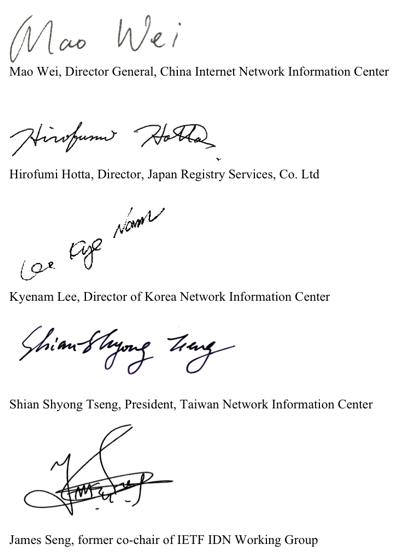Rod Beckstrom
President and Chief Executive Officer
Internet Corporation for Assigned Names and Numbers (ICANN)
4676 Admiralty Way, Suite 330
Marina del Rey, CA 90292-6601
Cc: Tina Dam
Director, IDN Program
Internet Corporation for Assigned Names and Numbers (ICANN)
4676 Admiralty Way, Suite 330
Marina del Rey, CA 90292-6601
Dear Mr. Beckstrom,
In July 2000, CNNIC, JPNIC (now JPRS), KRNIC (now part of NIDA) and TWNIC jointly established Joint Engineering Team (JET) to develop and implement IDN technology. JET is responsible for drafting RFC 3743 that is commonly known as JET Guidelines for Chinese, Japanese and Korean IDN.
1) IDN Variant Problem. On 27th March 2003, ICANN Board endorsed the “Guidelines for the Implementation of Internationalized Domain Names” 1 with the following:
3. In implementing the IDN standards, top-level domain registries will (a) associate each registered internationalized domain name with one language or set of languages, (b) employ language-specific registration and administration rules that are documented and publicly available, such as the reservation of all domain names with equivalent character variants in the languages associated with the registered domain name, and, (c) where the registry finds that the registration and administration rules for a given language would benefit from a character variants table, allow registrations in that language only when an appropriate table is available.
The implementation of IDN variant is of utmost importance to our community as variants are often used interchangeably, similar although not the same, as uppercase and lowercase characters in English.
JET would like to urge ICANN to implement TLD with IDN variants, at least for the Chinese, Japanese and Korean strings, in according to RFC 3743.
Not implementing RFC 3743 would results registrants having to pay multiple times for the “same” domain name.
2) CJK Three Characters Problem. With reference to “Draft Application Guideline, Version 2” Page 2-11,
Policy Requirements for Generic Top-Level Domains – Applied-for strings must be composed of three or more visually distinct letters or characters in the script, as appropriate.
We would like to highlight that the policy of three or more visually distinct letter or characters is not practical for Chinese, Japanese and Korean.
Chinese, Japanese and Korean are phonetic languages and CJK Ideographic characters are used to express the phonetics. A morpheme (“word”) can be expressed in one or more ideographs. This is quite different from English where a single or two characters are unlikely to have any meaning.
It should be noted that final report2 of the GNSO new TLDs Committee dated 23rd May 2007 include an sub-group report specifically on “Single and Two Characters Labels” dated 10th May 2007 recommended that for Single and Two Characters IDN labels,
Single and two-character U-labels on the top level and second level of a domain name should not be restricted in general. At the top level, requested strings should be analyzed on a case by case basis in the new gTLD process depending on the script and language used in order to determine whether the string should be granted for allocation in the DNS. Single and two character labels at the second level and the third level if applicable should be available for registration, provided they are consistent with the IDN Guidelines.
We would like to take the opportunity to address some of the objections raised in the “Discussion about 3-character String Requirements”3.
a) With respect to “Fairness of Treatment”,
There are 74,394 CJK Unified Ideographs in Unicode Version 5.1 where as there are 26 English alphabets. In other words, each ideograph has equivalent “information encapsulated” to more than 3 English alphabets (26*26*26 = 17,576).
It is not unusual to find Chinese or Japanese translation of an English text shorter by a magnitude of 3 times or more by character counts.
Therefore, ICANN cannot rely on “character counting” for fairness.
b) With respect to “Statements concerning the Chinese words and numbers of characters”
It should be noted that the statement “few Chinese characters are words” is wrong.
Every well-form Chinese character, on its own, has a meaning.
c) With respect to “ICANN ccTLD delegation function”
We agree that there is certain elegance in simple rule like two characters TLD are reserved for ccTLD that allows one to immediately identify the type of TLD it is from the string.
However, such rule may not be feasible in IDN ccTLD in the long run. For example, Singapore in Chinese is “新加坡”.
It should be noted that ccTLD Fast Track Draft Implementation Plan has no restriction that IDN ccTLD be two characters only.
We are also unaware of any intention from the Maintenance Agency for ISO 3166 country codes to expand the list beyond ASCII character codes.
Therefore, we do not recommend that this legacy rule should apply when it comes to IDN.
We understand that removing the three character restriction is a major policy decision. We have spoken to several would-be TLD applicants from Chinese and Japanese community, majority have expressed interest in TLD shorter 3-characters strings.
We share the same view that ICANN should be careful and prudent. We believe that IDN TLD should be carefully considered by ICANN with consultation with the relevant community.
For further correspondence, please contact us via James Seng (james@seng.sg).
Additional Note: While Korean language community has the same issues as Chinese and Japanese, it would take sometime to reach a consensus. We hope the three characters limitation for Korean IDN TLD would be removed when the Korean language community reached the consensus.
Best regards,

References:
1 http://www.icann.org/en/general/idn-guidelines-20jun03.htm
2 http://gnso.icann.org/issues/new-gtlds/final-report-rn-wg-23may07.htm
3 http://www.icann.org/en/topics/new-gtlds/three-character-30may09-en.pdf